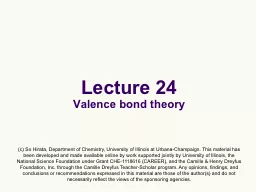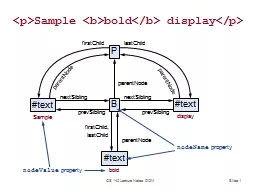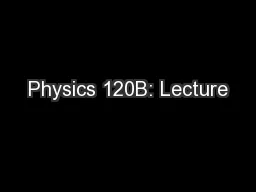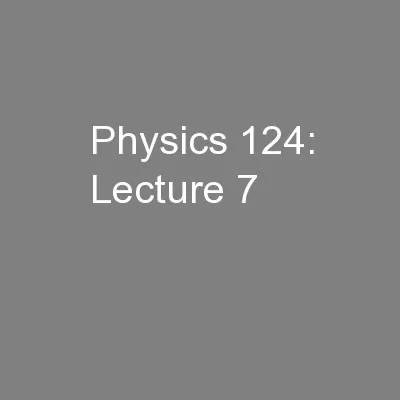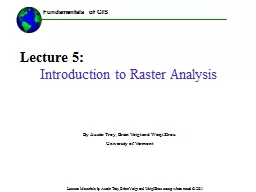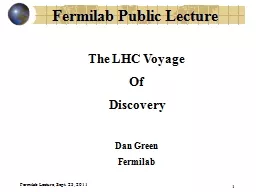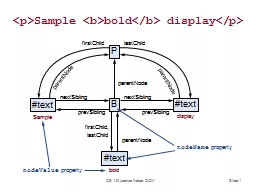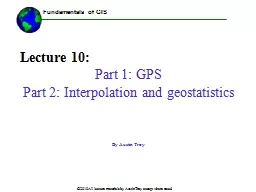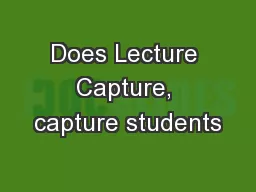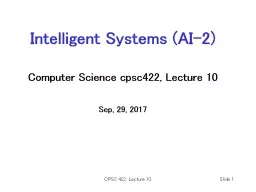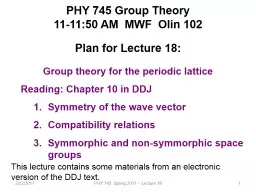PPT-Lecture 24
Author : lindy-dunigan | Published Date : 2016-08-05
Valence bond theory c So Hirata Department of Chemistry University of Illinois at UrbanaChampaign This material has been developed and made available online by
Presentation Embed Code
Download Presentation
Download Presentation The PPT/PDF document "Lecture 24" is the property of its rightful owner. Permission is granted to download and print the materials on this website for personal, non-commercial use only, and to display it on your personal computer provided you do not modify the materials and that you retain all copyright notices contained in the materials. By downloading content from our website, you accept the terms of this agreement.
Lecture 24: Transcript
Valence bond theory c So Hirata Department of Chemistry University of Illinois at UrbanaChampaign This material has been developed and made available online by work supported jointly by University of Illinois the National Science Foundation under Grant CHE1118616 CAREER and the Camille amp Henry Dreyfus Foundation Inc through the Camille Dreyfus TeacherScholar program Any opinions findings and conclusions or recommendations expressed in this material are those of the authors and do not necessarily reflect the views of the sponsoring agencies. The problem is that this information is oftenly unknown LMS is a method that is based on the same principles as the met hod of the Steepest descent but where the statistics is esti mated continuously Since the statistics is estimated continuously th Slide . 1. <. p>Sample . <b>bold</b> display</p>. P. B. #text. #text. nextSibling. prevSibling. nextSibling. prevSibling. firstChild. lastChild. parentNode. parentNode. parentNode. More than Just Capturing Lectures. Bill King. What is Lecture Capture?. Lecture Capture is the use of a set of technologies to capture and then enable time-shifted and place-shifted viewing of the Lecture Content.. Slide . 1. Google Datacenter. CS 142 Lecture Notes: Datacenters. Slide . 2. Datacenter Organization. Rack:. 50 machines. DRAM: . 800-3200GB . @ 300 . µs. Disk: 100TB @ 10ms. Single server:. 8-24 . cores. 4. LCD Text Display. Keypads and Time Slicing. Interrupts. 2×16 LCD . Typically 5×8 dots per character. Note 16 pins: indicator of common interface. Lecture 4. 2. Typical LCD Unit . pinout. pin. function. Sensors. (bit incomplete. , still). Sensing Categories. Voltage. starting easy: analog in. Distance. acoustic or light. Speed. hard; usu. via distance. Acceleration. accelerometers. Light Level. phototransistors, photodiodes. Troy, Brian Voigt and . Weiqi. Zhou . except where noted © . 2011. Lecture 5:. Introduction to Raster . Analysis. ------Using GIS--. By Austin . Troy, Brian Voigt . and . Weiqi. . Zhou. University . with. Students. Carl S. Moore, Assistant Director . Carl.moore@temple.edu. Teaching and Learning Center. Temple University . Wood, D., Bruner, J. S., & Ross, G. (1976). The Role of Tutoring in Problem Solving*. Journal of child psychology and psychiatry, 17(2), 89-100.. 1. The LHC Voyage . Of. Discovery . Dan Green. Fermilab. Fermilab Lecture, Sept. 23, 2011. 2. What is Particle Physics?. Particle physics is the modern name for the centuries old effort to understand the laws of nature. . Slide . 1. <. p>Sample . <b>bold</b> display</p>. P. B. #text. #text. nextSibling. prevSibling. nextSibling. prevSibling. firstChild. lastChild. parentNode. parentNode. parentNode. Lecture 10:. Part 1: GPS. Part 2: Interpolation and . geostatistics. By Austin Troy. ------Using GIS--. Lecture Materials by Austin Troy, Weiqi Zhou and Jarlath O’Neil Dunne© 2008. Part 1:. Global Positioning System. In online and blended learning platforms. An experiment with technology . Margaret Conlon. Edinburgh Napier University. Regularly used in dazzlingly large lectures….. But received some criticism…. 1. Intelligent Systems (AI-2). Computer Science . cpsc422. , Lecture . 10. Sep, 29. , 2017. CPSC 422, Lecture 10. 2. Lecture Overview. Finish Reinforcement learning. Exploration vs. Exploitation. On-policy Learning (SARSA). 1. PHY 745 Group Theory. 11-11:50 AM MWF Olin 102. Plan for Lecture 24:. Jahn. -Teller Effect. S. ection 7.7 in . DDJ. Example of tetrahedral molecule with doubly or triply degenerate electronic states..
Download Document
Here is the link to download the presentation.
"Lecture 24"The content belongs to its owner. You may download and print it for personal use, without modification, and keep all copyright notices. By downloading, you agree to these terms.
Related Documents

